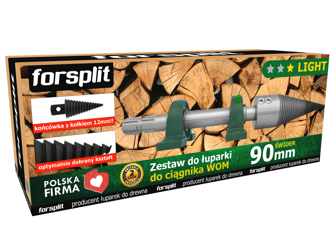Wood splitters - types and application
The splitter is a useful mechanical device that greatly facilitates the process of splitting wood blocks into smaller pieces - thanks to the splitter it is possible to split and split them quickly and efficiently. Depending on the purpose of the splitter and the expected processing power of this device, it is divided. As a result, several types are distinguished, each of which differs from the other possibilities, and thus parameters such as the type of drive or power.
Here are three main types of splitters:
Types of splitters - differences in construction
 Each wood splitter has a drive, but depending on the specific needs of the user, specific differences in the construction of these devices are visible. For example - there are models equipped with a drive operating thanks to an electric motor with a pulley or drive in the form of an agricultural tractor, operating on the basis of a power take-off shaft (PTO).
Each wood splitter has a drive, but depending on the specific needs of the user, specific differences in the construction of these devices are visible. For example - there are models equipped with a drive operating thanks to an electric motor with a pulley or drive in the form of an agricultural tractor, operating on the basis of a power take-off shaft (PTO).
The main difference between the different types of splitters is their operating principle, although in the case of kinetic and hydraulic splitters it is very similar: the block is pressed against the wedge which splits it into parts, they differ significantly in construction. Drill splitters work on a completely different principle, because the operator presses the block slightly against the drill, after which the drill begins to pull it on and split into parts. Depending on the power of the drive used and the diameter of the drill bit in the case of drill splitters depends on which logs the wood splitter will cope.
Drill splitters - operating principles
Drill splitters are the type we meet most often and they are the most popular. This is due to its construction, capabilities and operation - it is built of a simple but functional base set, which consists of:
- the bearings with the shaft - a solid hub or self-aligning bearings
- drill bit of suitable diameter - diameter from 60 to 170 mm, which is selected taking into account the size of the blocks to be subjected to the splitting process
- work table - a solid foundation on which the whole splitting structure rests.
The drill splitter is a device that works thanks to the use of rotary motion - the special design of the aforementioned drill used to split wood logs is also significant.
Kinetic splitters - operating principles
Kinetic splitters allow for quick and efficient splitting of wood, because these models use, as the name suggests, the power of kinetic energy. Users usually value kinetic splitters because of their quiet and fast operation.
This type of log splitter works on the basis of a flywheels system - a block to be machined is pressed against a specially mounted wedge. Thanks to its varied drive power, and therefore changing pressure, it can be used at home - for such needs, a 5 ton splitter is enough, while in industrial production it can be up to several dozen tons.
The kinetic splitter automatically retracts the clamping mechanism after splitting - thanks to this the splitter has a high level of safety. The splitting speed of wood blocks offered by a kinetic splitter is compared to the speed of a drill splitter.
Hydraulic splitters - operating principles
 Hydraulic splitters are a more advanced type of this device - it is a good device for use in large farms and industrial plants, where we split really large logs and the splitting speed is not so important.
Hydraulic splitters are a more advanced type of this device - it is a good device for use in large farms and industrial plants, where we split really large logs and the splitting speed is not so important.
Of course, a higher price goes hand in hand with their higher level of advancement.
- the hydraulic splitter works similarly to the kinetic one mentioned above - the processed wooden blocks are also pressed against a special wedge, but the difference lies in the use of a hydraulic pump, which is driven by an engine and an actuator
- its task is to pump oil and move the piston in the cylinder that presses the logs
- when the oil is fed to the other side of the piston, retraction of the pressing mechanism and preparation for the next splitting operation will begin.
The differences in relation to the others can already be seen at the construction level, because each hydraulic splitter consists of the following elements:
- engine (combustion or electric),
- actuator,
- hydraulic pump,
- wood splitting wedge.
Unfortunately, due to this complicated construction, this type of splitter is one of the slowest.
The use of wood splitters
The use of splitters differs depending on their level of advancement and the pressure force mentioned. Nevertheless, they are especially useful in the face of tasks such as:
- firewood preparation
- tidying up the garden
- usefulness in services, sawmills and wind mills
As it has already been mentioned many times - splitting machines are therefore used both in home workshops, for example for splitting wood for fuel, as well as in woodworking plants or manufacturing companies. In any case, they replace a traditional ax or power saw, which allows you to increase processing capacity and reduce wood processing time.
Recommended

Cone for log splitter 90mm, with replaceable tip (dowels)

Screw log splitter 150mm with pulley / kit ZK2P-150K2

